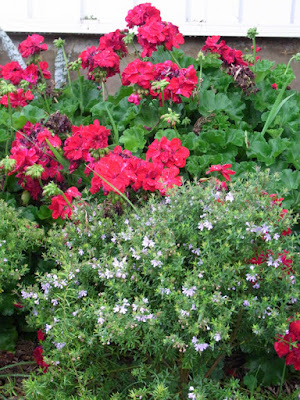I love all the little experiments that I conduct in this garden, especially those which take a few years for the results to burst into bloom.
This morning, I can report that all the work saving the seed of our Love-in-a-Mist (Nigella) flowers a few years ago has resulted in a small but very pretty show of self-seeded, multi-coloured Love-in-a-Mist blooms this morning. Here's a blue one.
The experiment goes back to late 2013, when I collected the seed of the Nigella flowers after they finished blooming. I then planted the seed the next autumn, and in October 2014 they bloomed in the same mix of colours as the original seed packet. Next phase of the experiment was to do nothing. That's right, folks. Do nothing. I know that Nigella is considered a weed in some climates, so I figured that virtually anything and everything grows here in Sydney, so mine should do the same and not need any help from me.
In midwinter this year I noticed the first ferny shoots of Nigella coming up, so all I did to help them along was pull out the usual bunch of weeds trying to smother them (and everything else here).
Being good weeds themselves, the Nigella have been growing and forming flower buds since then, but the big question for my experiment was "which colours will I get?". I suspected they might all default to just one colour. Well, so far the answer is two colours! White and blue, but there are lots of buds left, and for the perfect result to replicate the original seed packet I bought in early 2013 is that I'll need some pale pink ones, too.
I like everything about Love-in-a-Mist. The flowers are pretty but a bit weird with that ferny lacework (the "mist") around them. And the flower buds are definitely up there on the "ain't nature wonderful" scale of interesting things that only nature can design.
I'm happy for these flowers to become an established, self-seeding part of our garden. The more life goes on, the more I see all the annually flowering established plants that pop up every year as gentle, pretty little companions in my life.
They mark the coming and going of the seasons (and the years), and it's not just the flowers that we notice. It's their whole life cycle, the emergence of the buds, the blooming itself, their inevitable fading and, in the case of several of them, their modest green summers as leafy people quietly building up energy reserves for their big show next year.










































